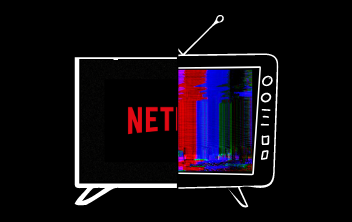Television is here to stay. Art by Leah Quintero /The Bulletin.
By Anthony Arroyo Staff Reporter
Television has been a staple in American households since the 1950s, and with the introduction of cable, television seemed to have reached its peak. However, many have predicted that television will become completely obsolete in the next decade.
In the recent decade, cable subscriptions have been steadily declining, and the use of streaming services has increased. Platforms such as Hulu, HBO Max, and Disney Plus have risen to prominence. With the ability to watch shows whenever and wherever they want, consumers do not feel the need to keep paying for cable.
Television can have a different meaning depending on who you ask. To many, it can be as simple as the physical screen that occupies one’s living room. To some, it can be defined as a business that gains money from whatever programming is on the air. To others, it can be an entire world they put themselves into and experience whenever they are watching their favorite shows. Regardless of the definition one gives to television, it is not dying, but instead, it is evolving.
Although the number of consumers who pay for cable is declining, it is important to note that cable is not television; it is just a way to watch television, as is streaming. Streaming devices such as the Apple TV and Roku are not the new form of television, but rather an add-on to the already existing form of television.
The way people watch may change from time to time, as many people enjoy watching content on their smartphones or laptops. However, the traditional form of television will always be around, especially with sporting events such as the World Cup and Super Bowl. Those events are usually broadcasted on networks that do not require cable or streaming services, so anyone in the world can watch. It is still possible that streaming coexists with the traditional form of television.
“One of the things that tend to happen in the course of media history is something new will come along and people will think that will replace whatever came before, but usually what ends up happening is it exists alongside it,” Todd Kushigemachi, a film, television and media professor at California State University Dominguez Hills, said. “TV existed alongside movies, cable existed alongside the networks, and I think streaming is sort of that new space where it’s kind of absorbing movies and TV.”
When television first became a mainstay in American households, the three networks that made up all of the programs were ABC, NBC and CBS. Since then, those networks have branched out and have had their presence felt in the streaming world, whether it is through their own platforms or through other streaming services. Original programming from those networks has made its way to some of those newer streaming platforms. This goes to show that streaming platforms, especially the ones mentioned earlier, are all a product of the original form of television.
It is difficult to argue that television is dying when the word itself is used to describe an entire concept of media. Television went from becoming one little small screen in your living room to virtually the world around you. With every form of new media that is introduced, television continues to be the common denominator and changes with the times.

